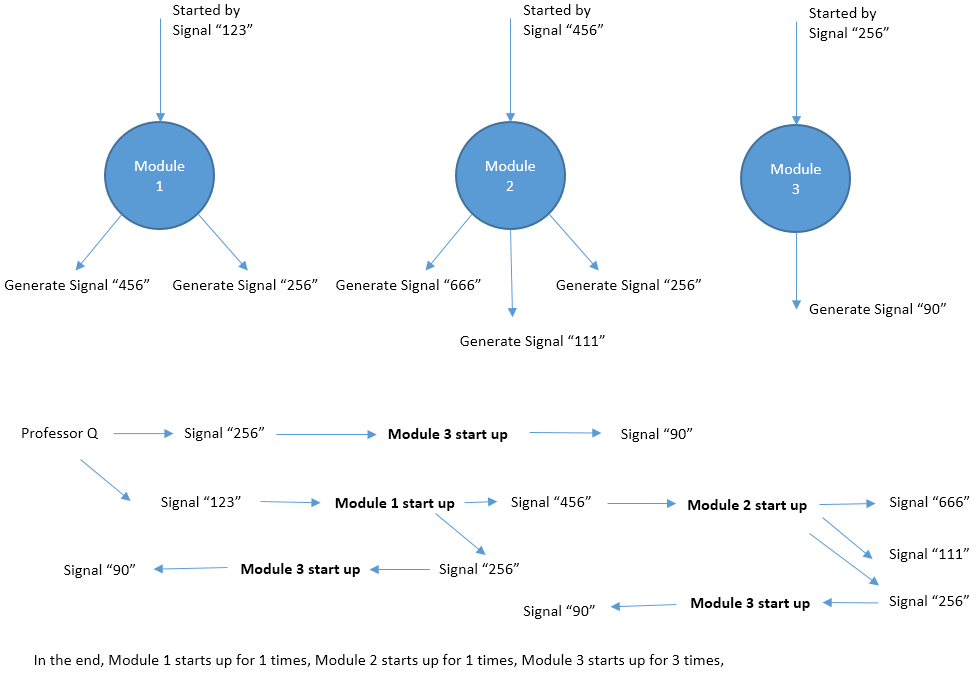微软2016校园招聘在线笔试-Professor Q's Software
2015-04-04 22:48
267 查看
题目2 : Professor Q's Software
时间限制:10000ms单点时限:1000ms
内存限制:256MB
描述
Professor Q develops a new software. The software consists of N modules which are numbered from 1 to N. The i-th module will be started up by signal Si. If signal Si is generated multiple times, the i-th module will also be started multiple times. Two different modules may be started up by the same signal. During its lifecircle, the i-th module will generate Ki signals: E1, E2, ..., EKi. These signals may start up other modules and so on. Fortunately the software is so carefully designed that there is no loop in the starting chain of modules, which means eventually all the modules will be stoped. Professor Q generates some initial signals and want to know how many times each module is started.
输入
The first line contains an integer T, the number of test cases. T test cases follows.For each test case, the first line contains contains two numbers N and M, indicating the number of modules and number of signals that Professor Q generates initially.
The second line contains M integers, indicating the signals that Professor Q generates initially.
Line 3~N + 2, each line describes an module, following the format S, K, E1, E2, ... , EK. S represents the signal that start up this module. K represents the total amount of signals that are generated during the lifecircle of this module. And E1 ... EK are these signals.
For 20% data, all N, M <= 10
For 40% data, all N, M <= 103
For 100% data, all 1 <= T <= 5, N, M <= 105, 0 <= K <= 3, 0 <= S, E <= 105.
Hint: HUGE input in this problem. Fast IO such as scanf and BufferedReader are recommended.
输出
For each test case, output a line with N numbers Ans1, Ans2, ... , AnsN. Ansi is the number of times that the i-th module is started. In case the answers may be too large, output the answers modulo 142857 (the remainder of division by 142857).样例输入
3 3 2 123 256 123 2 456 256 456 3 666 111 256 256 1 90 3 1 100 100 2 200 200 200 1 300 200 0 5 1 1 1 2 2 3 2 2 3 4 3 2 4 5 4 2 5 6 5 2 6 7
样例输出
1 1 3 1 2 2 1 1 2 3 5
直接使用bfs即可:
#include <iostream>
#include <cstdlib>
#include <vector>
#include <unordered_map>
#include <queue>
using namespace std;
class Module {
public:
int fanin;
int access;
vector<int> fanout;
Module():access(0){}
};
int main() {
int T, N, M;
scanf("%d", &T);
for (int i=0; i<T; i++) {
scanf("%d%d", &N, &M);
// signal slot
unordered_map<int, vector<int> > singal_slot;
// module & signal
vector<Module> mods(N);
queue<int> signals;
// inital signals
for (int i=0; i<M; i++) {
int ts;
scanf("%d", &ts);
signals.push(ts);
}
// read module define
for (int i=0; i<N; i++) {
int S, K;
scanf("%d%d", &S, &K);
if (singal_slot.count(S) == 0) {
// create slot first
singal_slot.insert(make_pair(S, vector<int>()));
}
// slot must exist now, register mod
vector<int>& wired_mods = singal_slot[S];
wired_mods.push_back(i);
// add fanout signal for current mod
mods[i].fanin = S;
vector<int>& outsig = mods[i].fanout;
for (int i=0; i<K; i++) {
int os;
scanf("%d", &os);
outsig.push_back(os);
}
}
while (!signals.empty()) {
int sig = signals.front();
signals.pop();
//printf("read signal %d\n", sig);
// retrive the fired mods from signal slot
if (singal_slot.count(sig) == 0) {
// no module fired by this signal
continue;
}
vector<int>& ms = singal_slot[sig];
int mlen = ms.size();
for (int i=0; i<mlen; i++) {
Module& mod = mods[ms[i]];
// access it
mod.access++;
// fanout signal
vector<int>& outsigs = mod.fanout;
for (int i=0; i<outsigs.size(); i++) {
//printf("fanout: %d\n", outsigs[i]);
signals.push(outsigs[i]);
}
}
}
// one iteration over
if (N) {
printf("%d", mods[0].access);
}
for (int i=1; i<N; i++) {
printf(" %d", mods[i].access);
}
printf("\n");
}
//system("pause");
return 0;
}
相关文章推荐
- 微软2016校园招聘在线笔试 B Professor Q's Software [ 拓扑图dp ]
- 微软2016校园招聘在线笔试第二场 题目1 : Lucky Substrings
- 微软2016校园招聘在线笔试第二场 题目1 : Lucky Substrings
- 微软2016校园招聘在线笔试第二场——Lucky Substrings
- 【hihocoder1290 微软2016校园招聘4月在线笔试C】【二维DP】 Demo Day 机器人遇到障碍向右走向下走 最少调整数使得左上角走到右下角
- 微软2016校园招聘4月在线笔试题目解析
- hihocoder: 1239 Fibonacci(微软2016校园招聘9月在线笔试)
- 微软2016校园招聘4月在线笔试 A FontSize
- 【hihocoder1291 微软2016校园招聘4月在线笔试D】【逆序思维 并查集】Buiding in Sandbox 我的世界建方块合法性判定
- 微软2016校园招聘在线笔试第二场
- 微软2016校园招聘4月在线笔试 ABC
- 微软2016校园招聘在线笔试: [Islands Travel]
- [Hihocoder 1289] 403 Forbidden (微软2016校园招聘4月在线笔试)
- 微软2016校园招聘4月在线笔试:Font Size
- HiHocoder #1136 : Professor Q's Software 微软2016校园招聘在线笔试 【拓扑排序+DP】
- 微软2016校园招聘在线笔试题目-第一题 Magic Box
- 微软2016校园招聘9月在线笔试C.Fibonacci
- Lucky Substrings 微软2016校园招聘在线笔试第二场
- hihocoder: 1239 Fibonacci(微软2016校园招聘9月在线笔试)
- hihocoder 1290 -- 微软2016校园招聘4月在线笔试-3-Demo Day
